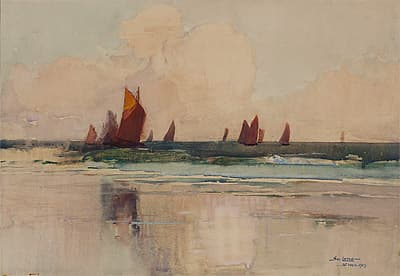Sydney
LONG
Australia
1871
–
London
1955
England, Europe 1910-21; Australia 1921- 22; England 1922-25; Australia 1925-52; England from 1952
34.0 (h) x 49.0 (w) cm
signed and dated ‘SID LONG/ ST IVES 1917’ lower right Wollongong City Art Gallery, purchased through the George and Nerissa Johnson Memorial Bequest 1994 Wollongong City Art Gallery, gift of Bob Sredersas 1976
In Herring fleet at St Ives, Long depicted a group of fishing boats with terracotta sails, sailing on an expanse of water, and their shimmering reflections near the shore.
Long first visited St Ives, Cornwall, in October 1911, writing that it ‘literally stinks with artists, good bad and indifferent’. He observed that ‘in the hotel where I stayed the first night the walls were covered with paintings, some very good’. ‘St Ives is a quaint old place’, Long wrote, probably referring to its winding streets lined with old-fashioned cottages. But, it also had a lively waterfront with a variety of fishing boats, sandy beaches and dramatic cliffs. It was ideally suited to marine and landscape painters who enjoyed painting outdoors in a temperate climate and capturing the clear translucent light.
Long visited Cornwall again in 1912, and again during the First World War. He wanted to escape from the ‘war fever’ in London, where people were constantly on the lookout for spies. He felt that ‘you daren’t hold a brush or be seen with a sketch book except in some very remote corner of the West Coast such as Newlyn or St Ives and where the artists almost own the place’ (Long, undated letter, c 1918). It was during such a wartime visit that he painted this peaceful watercolour.
In Herring fleet at St Ives, Long depicted a group of fishing boats with terracotta sails, sailing on an expanse of water, and their shimmering reflections near the shore.
Long first visited St Ives, Cornwall, in October 1911, writing that it ‘literally stinks with artists, good bad and indifferent’. He observed that ‘in the hotel where I stayed the first night the walls were covered with paintings, some very good’. ‘St Ives is a quaint old place’, Long wrote, probably referring to its winding streets lined with old-fashioned cottages. But, it also had a lively waterfront with a variety of fishing boats, sandy beaches and dramatic cliffs. It was ideally suited to marine and landscape painters who enjoyed painting outdoors in a temperate climate and capturing the clear translucent light.
Long visited Cornwall again in 1912, and again during the First World War. He wanted to escape from the ‘war fever’ in London, where people were constantly on the lookout for spies. He felt that ‘you daren’t hold a brush or be seen with a sketch book except in some very remote corner of the West Coast such as Newlyn or St Ives and where the artists almost own the place’ (Long, undated letter, c 1918). It was during such a wartime visit that he painted this peaceful watercolour.
In Herring fleet at St Ives, Long depicted a group of fishing boats with terracotta sails, sailing on an expanse of water, and their shimmering reflections near the shore.
Long first visited St Ives, Cornwall, in October 1911, writing that it ‘literally stinks with artists, good bad and indifferent’. He observed that ‘in the hotel where I stayed the first night the walls were covered with paintings, some very good’. ‘St Ives is a quaint old place’, Long wrote, probably referring to its winding streets lined with old-fashioned cottages. But, it also had a lively waterfront with a variety of fishing boats, sandy beaches and dramatic cliffs. It was ideally suited to marine and landscape painters who enjoyed painting outdoors in a temperate climate and capturing the clear translucent light.
Long visited Cornwall again in 1912, and again during the First World War. He wanted to escape from the ‘war fever’ in London, where people were constantly on the lookout for spies. He felt that ‘you daren’t hold a brush or be seen with a sketch book except in some very remote corner of the West Coast such as Newlyn or St Ives and where the artists almost own the place’ (Long, undated letter, c 1918). It was during such a wartime visit that he painted this peaceful watercolour.

